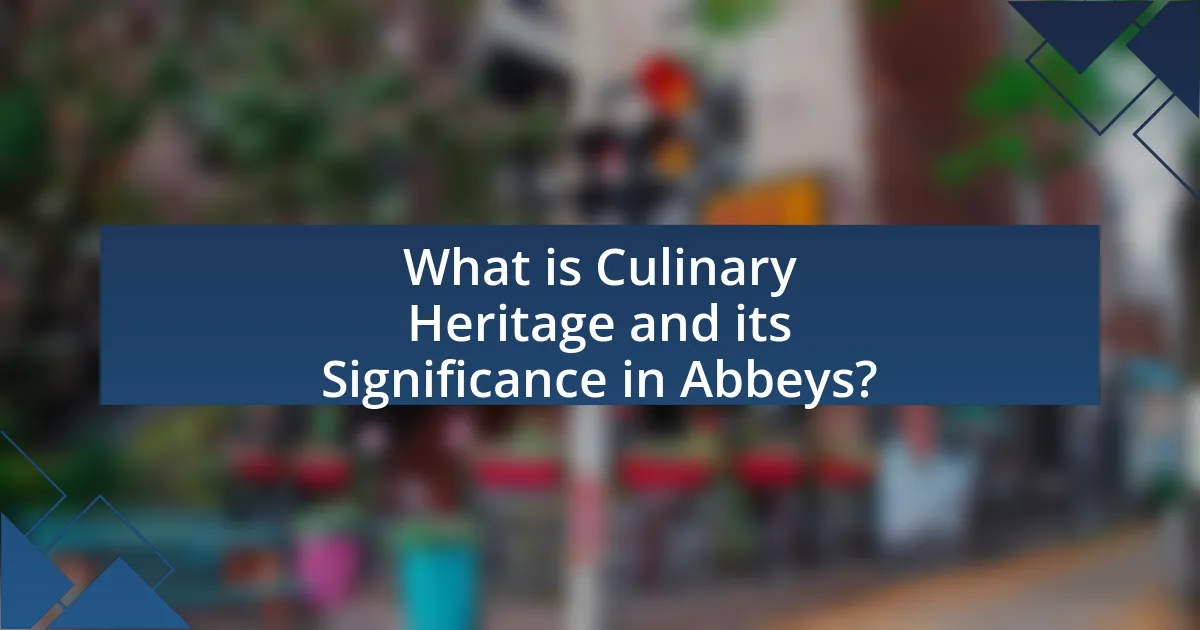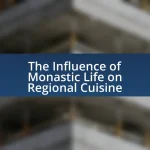Culinary heritage encompasses the traditional cooking practices, recipes, and food customs that reflect the cultural identity of communities, particularly within abbeys. This article explores the significance of culinary heritage in abbeys, highlighting how these religious institutions preserve traditional recipes and food production methods, such as brewing and cheese-making, that have been passed down through generations. It examines the historical factors influencing abbey culinary practices, the role of traditional foods in monastic life, and how local ingredients shape abbey recipes. Additionally, the article discusses notable traditional foods from abbeys worldwide, common cooking techniques, and ways to experience and learn about abbey culinary traditions today.

What is Culinary Heritage and its Significance in Abbeys?
Culinary heritage refers to the traditional cooking practices, recipes, and food-related customs that are passed down through generations, often reflecting the cultural identity of a community. In the context of abbeys, culinary heritage is significant as it embodies the monastic way of life, where monks historically cultivated ingredients and prepared meals that adhered to religious principles, such as simplicity and sustainability. For example, many abbeys have maintained unique brewing techniques for beer or specific recipes for bread that are tied to their local environment and monastic traditions, thus preserving both culinary skills and cultural history. This heritage not only contributes to the local economy through food tourism but also fosters a sense of community and continuity in culinary practices.
How do abbeys contribute to the preservation of culinary heritage?
Abbeys contribute to the preservation of culinary heritage by maintaining traditional recipes and food production methods that have been passed down through generations. Many abbeys, particularly in Europe, have a long history of brewing beer, producing cheese, and cultivating herbs, which are integral to their local culinary traditions. For example, Trappist monasteries are renowned for their beer, with specific brewing techniques that date back centuries, ensuring that these practices are preserved and celebrated. Additionally, abbeys often engage in sustainable farming practices, which not only support local ecosystems but also keep traditional agricultural methods alive, further enriching the culinary heritage associated with their regions.
What historical factors influence the culinary practices in abbeys?
Historical factors that influence the culinary practices in abbeys include monastic rules, local agricultural practices, and the availability of resources. Monastic rules, such as those established by St. Benedict in the 6th century, dictated dietary restrictions and encouraged self-sufficiency, leading to the cultivation of specific crops and livestock. Local agricultural practices shaped the types of ingredients used, as abbeys often relied on what was available in their surrounding environment. Additionally, the availability of resources, including trade routes and seasonal variations, impacted the diversity of ingredients and culinary techniques adopted by abbey kitchens. These factors collectively contributed to the unique culinary heritage observed in abbeys worldwide.
How do abbey traditions shape local food culture?
Abbey traditions significantly shape local food culture by promoting the use of traditional recipes and local ingredients, often rooted in centuries-old practices. Monastic communities historically cultivated their own gardens and farms, leading to the production of unique food items such as cheeses, breads, and beers that reflect regional flavors and agricultural practices. For example, Trappist monasteries are renowned for their beer brewing, which not only supports the abbey’s economy but also influences local brewing traditions. Additionally, abbeys often serve as centers for culinary education, preserving and passing down techniques that contribute to the local gastronomic identity. This interplay between abbey practices and local food culture fosters a rich culinary heritage that is celebrated in various regions around the world.
What role do traditional foods play in abbey life?
Traditional foods play a central role in abbey life by fostering community, supporting monastic values, and preserving cultural heritage. These foods are often prepared using age-old recipes that reflect the abbey’s history and the agricultural practices of the region. For example, many abbeys produce their own beer, cheese, and bread, which not only sustains the monks but also serves as a means of generating income for the abbey. The preparation and sharing of these traditional foods during communal meals reinforce bonds among the monks and embody the principles of hospitality and simplicity that are integral to monastic life.
How are traditional recipes passed down through generations in abbeys?
Traditional recipes in abbeys are passed down through generations primarily via oral tradition and written manuscripts. Monastic communities often emphasize the importance of preserving culinary heritage, leading to the meticulous documentation of recipes in recipe books or journals maintained by the abbey. These texts serve as both instructional guides and historical records, ensuring that the techniques and ingredients used in traditional dishes are accurately conveyed. Additionally, novice monks and nuns learn from experienced members through hands-on training in the kitchen, reinforcing the transmission of culinary knowledge. This practice is supported by the historical context of abbeys, where many have been operational for centuries, allowing for a rich lineage of culinary practices to develop and be preserved.
What are the spiritual and communal aspects of cooking in abbeys?
Cooking in abbeys embodies both spiritual and communal aspects, serving as a means of fostering unity and devotion among the monastic community. The act of preparing meals is often seen as a form of prayer, where the process is imbued with mindfulness and gratitude, reflecting the abbey’s spiritual values. Monks and nuns engage in cooking as a communal activity, reinforcing bonds through shared labor and the enjoyment of meals together, which is integral to their daily life and spiritual practice. Historical records indicate that many abbeys have developed unique culinary traditions that not only sustain the community but also symbolize their commitment to hospitality and service, further enhancing the spiritual significance of cooking within these religious settings.

What are the Most Notable Traditional Foods from Abbeys Worldwide?
The most notable traditional foods from abbeys worldwide include Trappist cheeses, Belgian ales, and various types of bread. Trappist cheeses, such as those produced by monks in Belgium and the Netherlands, are renowned for their rich flavors and artisanal quality, often made using traditional methods that date back centuries. Belgian ales, brewed by Trappist monks in monasteries like Westvleteren and Chimay, are celebrated for their unique brewing techniques and complex flavors, contributing significantly to the region’s beer culture. Additionally, many abbeys produce distinctive breads, such as the “Pain de Moin” from French monasteries, which reflects the local ingredients and baking traditions. These foods not only represent the culinary heritage of the abbeys but also embody the monastic commitment to craftsmanship and quality.
Which abbeys are renowned for their unique culinary offerings?
Certain abbeys are renowned for their unique culinary offerings, notably the Trappist abbeys. Trappist monks produce distinctive products such as cheese, beer, and bread, which are highly regarded. For example, the Abbey of Westmalle in Belgium is famous for its Trappist beer, while the Abbey of Chevetogne is known for its artisanal cheeses. These abbeys maintain traditional recipes and methods that have been passed down through generations, contributing to their culinary reputation.
What specific dishes are associated with famous abbeys?
Specific dishes associated with famous abbeys include Trappist cheese from Trappist monasteries, Belgian abbey beers brewed by monks, and the traditional dish of coq au vin from the Abbey of Saint-Benoît-du-Lac in Canada. Trappist cheese is known for its rich flavor and is produced in various abbeys across Europe, particularly in Belgium and the Netherlands. Belgian abbey beers, such as Dubbel and Tripel, are crafted by monks following centuries-old brewing traditions, contributing to the unique taste and quality recognized worldwide. Coq au vin, a classic French dish, is often linked to the culinary practices of the Abbey of Saint-Benoît-du-Lac, showcasing the abbey’s influence on local gastronomy.
How do local ingredients influence abbey recipes?
Local ingredients significantly influence abbey recipes by shaping the flavors, textures, and nutritional profiles of the dishes. Abbeys often utilize ingredients sourced from their immediate surroundings, such as herbs, grains, and vegetables, which reflect the local terroir and climate. For example, Trappist monasteries in Belgium are known for their beers brewed with locally grown hops and barley, resulting in unique flavor profiles that are distinct to the region. This practice not only enhances the authenticity of the recipes but also supports sustainable agriculture and local economies. Historical records indicate that many abbey recipes have evolved over centuries, adapting to the seasonal availability of local produce, which further solidifies the connection between local ingredients and the culinary traditions of these religious communities.
What are the common cooking techniques used in abbey kitchens?
Common cooking techniques used in abbey kitchens include baking, boiling, and preserving. These methods were essential for monks to create sustenance from locally sourced ingredients. Baking was often employed for bread and pastries, reflecting the importance of grain in monastic diets. Boiling was utilized for soups and stews, allowing for the combination of various vegetables and meats. Preserving techniques, such as pickling and fermenting, were crucial for extending the shelf life of food, especially in regions with harsh winters. Historical records indicate that these techniques were not only practical but also integral to the culinary traditions that developed within abbey kitchens across Europe.
How do traditional cooking methods differ from modern practices?
Traditional cooking methods emphasize slow, labor-intensive processes using natural ingredients, while modern practices often prioritize speed and convenience through technology and processed foods. For instance, traditional methods may involve techniques like fermentation, smoking, or slow roasting, which enhance flavors and preserve food, whereas modern practices frequently utilize microwaves, pressure cookers, and pre-packaged ingredients to save time. Historical evidence shows that traditional cooking has been passed down through generations, often reflecting local cultures and seasonal availability, while modern cooking tends to be influenced by globalization and mass production, leading to a homogenization of flavors and techniques.
What equipment is typically found in an abbey kitchen?
An abbey kitchen typically contains large wooden tables, stone hearths, and various cooking utensils such as pots, pans, and knives. These kitchens are designed for communal cooking and often include equipment like bread ovens, fermentation vessels, and storage containers for grains and herbs. Historically, abbey kitchens were equipped to support the preparation of meals for monks and visitors, emphasizing the use of simple, durable materials that reflect the monastic lifestyle.

How Can One Experience Abbey Culinary Heritage Today?
One can experience Abbey culinary heritage today by visiting abbey restaurants or participating in culinary workshops that focus on traditional recipes. Many abbeys, particularly in Europe, offer dining experiences where visitors can enjoy meals prepared using age-old recipes that reflect the local culture and monastic traditions. For instance, the Abbey of Mont-Saint-Michel in France features a restaurant that serves dishes inspired by the region’s history and monastic cooking methods. Additionally, culinary workshops hosted by various abbeys allow participants to learn about and recreate traditional dishes, providing hands-on experience with the ingredients and techniques used by monks historically. This approach not only preserves the culinary heritage but also educates visitors about the significance of these traditions in contemporary cuisine.
What are the best ways to learn about abbey recipes?
The best ways to learn about abbey recipes include studying historical cookbooks, visiting abbeys with culinary programs, and participating in workshops or classes focused on monastic cooking traditions. Historical cookbooks often contain authentic recipes passed down through generations, providing insight into the ingredients and techniques used by monks. Many abbeys, particularly in Europe, offer culinary experiences where visitors can learn directly from monks or chefs about traditional cooking methods. Additionally, workshops or classes that focus on abbey cuisine can provide hands-on experience and deeper understanding of the cultural significance behind these recipes.
How can one participate in cooking classes or workshops at abbeys?
To participate in cooking classes or workshops at abbeys, individuals should first research specific abbeys that offer such programs, as not all abbeys provide cooking classes. Many abbeys, particularly in regions known for culinary heritage, have established programs that focus on traditional recipes and cooking techniques. Interested participants can typically find information on the abbey’s official website or by contacting them directly to inquire about schedules, availability, and registration processes. For example, abbeys in France and Italy often host culinary workshops that highlight local ingredients and historical cooking methods, making them accessible to both locals and tourists.
What resources are available for exploring abbey culinary traditions?
Resources for exploring abbey culinary traditions include cookbooks, online databases, and culinary heritage organizations. Notable cookbooks such as “The Monastery Kitchen” by Brother Victor-Antoine d’Avila-Latourrette provide authentic recipes and insights into monastic cooking practices. Online databases like the International Association of Monastic Communities offer access to various abbey recipes and culinary traditions from around the world. Additionally, organizations focused on culinary heritage, such as Slow Food, often highlight traditional foods and practices from abbeys, promoting awareness and preservation of these culinary traditions.
What tips can enhance the experience of cooking traditional abbey recipes?
To enhance the experience of cooking traditional abbey recipes, focus on using authentic ingredients and methods that reflect the historical context of the recipes. Authentic ingredients, such as locally sourced herbs and spices, can significantly impact flavor and authenticity, as many abbey recipes were developed using what was available in the surrounding environment. Additionally, employing traditional cooking techniques, such as slow cooking or fermentation, can replicate the original flavors and textures intended by the abbey cooks. Historical records indicate that many abbey recipes emphasize simplicity and the use of seasonal produce, which can also enhance the overall cooking experience by connecting the cook to the culinary traditions of the past.
How can one source authentic ingredients for abbey-style cooking?
To source authentic ingredients for abbey-style cooking, one should seek out local farms and specialty markets that focus on traditional agricultural practices. These sources often provide organic and heritage varieties of fruits, vegetables, grains, and herbs that align with the historical methods used in abbey kitchens. For example, many abbeys historically cultivated specific crops, such as barley for brewing or herbs for medicinal and culinary purposes, which can often be found at farmers’ markets or through community-supported agriculture (CSA) programs. Additionally, researching regional monasteries that still produce artisanal products, such as cheeses, breads, and preserves, can yield authentic ingredients reflective of abbey culinary traditions.
What are some common mistakes to avoid when preparing abbey dishes?
Common mistakes to avoid when preparing abbey dishes include neglecting the importance of fresh, high-quality ingredients, which are essential for authentic flavors. Using stale or low-quality ingredients can significantly alter the taste and authenticity of the dish. Additionally, failing to follow traditional cooking methods can lead to subpar results; many abbey recipes rely on specific techniques that have been perfected over centuries. For instance, not allowing sufficient time for marination or fermentation can compromise the depth of flavor that is characteristic of these dishes. Lastly, overlooking the significance of proper seasoning can result in bland meals, as abbey cuisine often emphasizes the balance of herbs and spices to enhance the overall profile.





